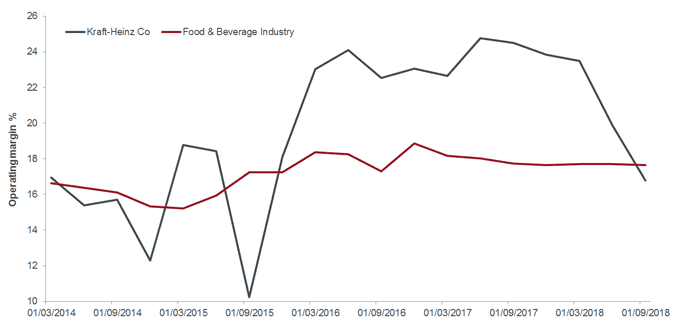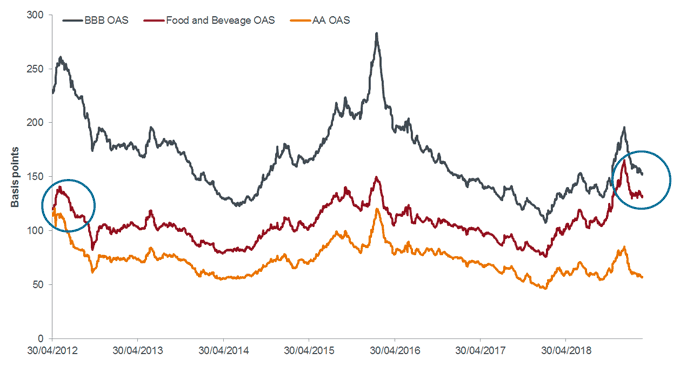Sector spotlight: food and beverage

John Lloyd, Co-Head of Credit Research, shines the spotlight on the food and beverage sector, exploring the challenges that the industry faces and what this might mean for bond investors.
The stable cash flows offered by historically defensive food and beverage companies can prove enticing for fixed income investors, particularly in an extended credit cycle where the timing of a potential economic downturn is in question. But past is not necessarily prologue. Disruption brought on by technology and a new generation of consumers has upended food and beverage’s relatively conservative paradigm, and with it forced companies to adjust. Companies that have been slow to adapt are at risk, especially those that have overemphasised managing their balance sheet at the expense of reengineering their business models to adjust to the rapidly evolving marketplace. In the discussion that follows, we delve into industry trends, how various companies are tackling the industry’s evolution and the implications for fixed income investors.
Battered by headwinds
The food and beverage industry has been battered by headwinds in recent years. Packaged food, the hallmark of large, legacy brands, has fallen out of favour. Today’s consumer tends to prefer natural and organic ingredients and fresh or ready-to-eat food options as opposed to the processed food of yesteryear. Another shift that has seemingly caught industry stalwarts flat-footed is private labels. These insurgents can offer comparable quality at a significant price discount and are thus taking market share from legacy brands. Retailers are applying further pressure as they adapt to shifting consumer preferences by reallocating shelf space to private labels, startup brands and fresh food options.
In addition, the staunch brand loyalty of previous generations is largely lost on millennials, who rely on – and are chiefly influenced by – digital communication channels that were not even available a decade ago. The pervasive use of the internet, and with it, the emergence of new advertising mediums, has broken down the industry’s largest barrier to entry. Today, a startup needs only an Instagram account and a set of influencers for a brand to be born; gone is the need for store-to-store sales and billion dollar advertising campaigns. The Internet has also introduced new distribution channels, as shoppers increasingly opt for the convenience of door-step delivery.
Cutting cost for profit
Concurrent with the industry evolution has been a wide-spread adoption of zero-based budgeting (ZBB) – a planning approach whereby the budget begins at ‘zero’ each year and every expense must be justified annually. Whereas many players have focused on reinvesting cost savings into brand renovation and innovation to help combat industry disruption and keep margins stable, others such as Kraft-Heinz were perhaps a little overzealous with their cost-cutting measures. The world’s fifth-largest food and beverage company and a large issuer of US investment grade credit has been at the vanguard of focusing on profitability at the expense of nearly all else. Such misplaced priorities, in our view, are behind the company’s notable Q4 earnings miss and the recent USD$15.4 billion write down in value of its best-known brands.
Brazilian private equity firm 3G Capital has long been a champion of ZBB and quickly implemented the practice at Kraft-Heinz, following its acquisitions of Heinz in 2013 and that of Kraft two years later. Through cost-cutting measures, Kraft-Heinz increased operating margins from 14.4% in 2015 to 23.2% in 2016, and continued to lay focus there. But there can be too much of a good thing. By our estimates, its first 4% of margin improvement created long-lasting efficiencies. However, with operating margins roughly 10% higher than the industry average, the company appears to have been overearning post-merger.
The fallout
In one respect, management was achieving its objective – and handsomely. But the other side of that coin was a failure to reinvest gains back into its brands, an incredibly important step given the significant shift in industry trends. With many of the company’s ‘go-to’ brands no longer holding the same power over consumers that they once enjoyed, Kraft-Heinz was forced to reduce the goodwill value of its Kraft and Oscar Mayer trademarks this year.
Operating margins at Kraft-Heinz have generally fallen since the original post-merger boost, whereas the industry margin has been more or less flat, even amid mounting headwinds (Chart 1). We believe that the company’s troubles stem from it overpromising on cost savings while failing to take into account the need to reinvigorate its once great brands.
CHART 1: Overearning at Kraft-Heinz Co.
[caption id=”attachment_75533″ align=”alignnone” width=”680″] Source: Bloomberg, as at 28 September 2018.[/caption]
Source: Bloomberg, as at 28 September 2018.[/caption]
Staying relevant
Kraft-Heinz is more the exception than the rule, in our view, as many of the once sleepy giants of the food and beverage industry have come alive to maintain relevance in today’s marketplace, even if it results in short-term pain. Some companies are investing in price (dropping prices to compete with private labels) in order to drum up volume and eventually top-line growth. We are also seeing signs of innovation. Kellogg, for instance, is investing in its supply chain and single-serve packaging formats, given the popularity of on-the-go food offerings. The company admits that the initiative may weigh on operating margins in the near term, but should ultimately lead to both organic and operating income growth over time.
Investment in the future, however, costs money, and often that has taken the form of debt-fuelled shopping sprees by legacy brand owners. A wave of consolidation has washed over the industry. Just last year, companies were willing to increase leverage and risk ratings downgrades in order to diversify business lines away from traditional centre aisle goods. Both General Mills and J.M. Smucker, for example, acquired pet food companies. Conagra Brands bought Pinnacle Foods. Campbell Soup purchased Snyder’s Lance. And this trend is not entirely new. Taking note of shifting consumer preferences, General Mills purchased the organic food brand Annie’s Homegrown for USD$820 million in 2014. In 2017, Kellogg paid USD$600 million for Chicago Bar Company, the makers of all-natural RXBar protein bars.
Kraft-Heinz, with its dogged focus on margins, has for the most part been caught on the wrong side of this shift. By neglecting brands during a generational industry transition, management lost the margin enhancing leverage it previously held over retailers – a reality evident in declining profitability. Investors are likely to be tolerant of margin compression if it is being driven by potentially high-return investment, less so when it’s due to loss of relevance and pricing power in the marketplace. Kraft-Heinz’ situation has been exacerbated both by climbing freight costs due to more stringent US trucking regulations and higher labour costs, given the tight US jobs market.
Bad stocks ≠ bad bonds
Margin improvement remains an important metric for investors to watch but may temporarily take a backseat for management teams as industry behemoths scramble to breathe life back into legacy brands. This is a tilt that may be less attractive for equity investors, especially given that the divestiture of assets could mean that equity multiples will be forever lower. From a bond perspective, however, the industry looks more attractive than it has in some time. Since emerging from the Global Financial Crisis, the sector has traded down from AA-like valuations to be more in line with BBB’s (Chart 2), and has consistently underperformed its peers in the investment grade index.
CHART 2: Investment grade food and beverage spreads
[caption id=”attachment_75522″ align=”alignnone” width=”680″] Source: Bloomberg, as at 22 March 2019. Notes: Bond ratings are measured on a scale that generally ranges from AAA (highest) to D (lowest). Option-adjusted spread (OAS) measures the spread between a fixed-income security rate and the risk-free rate of return, which is adjusted to take into account an embedded option.[/caption]
Source: Bloomberg, as at 22 March 2019. Notes: Bond ratings are measured on a scale that generally ranges from AAA (highest) to D (lowest). Option-adjusted spread (OAS) measures the spread between a fixed-income security rate and the risk-free rate of return, which is adjusted to take into account an embedded option.[/caption]
The extensive revaluation suggests that the industry’s headwinds are well acknowledged, and appropriately reflected in valuations. Further, the majority of these companies have made potentially transformative acquisitions, and investment into their brands, creating a visible path to growth. In a relatively rare occurrence for investment grade industries, nearly the entire industry is planning to pay down debt, and non-core divestitures are providing the cash to do it. A willingness to hold dividends steady, or to cut them (as in the case of Kraft-Heinz) is an additional proof point of the industry’s commitment to investment grade ratings and prudent capital structures. As these companies look to delever, active managers can benefit from analysing the capital structure to determine which bonds are ripe for pay down.
Wise investors will shop around
While earnings may not be ‘off to the races’, in the event of a downturn the steady cash flow of these consumer staples should be protected. That is not to say, however, that every company looks attractive. It is those that are investing in innovation and brand renovation that are going to be better off in the days ahead. Those that have relied on their everyday brands and cost-cutting their way to prosperity still have some work to do. Further, we expect the trend of industry consolidation to continue, making it imperative for investors to watch those names that have not yet utilised their balance sheets for signs of potential merger and acquisition activity.
These are the views of the author at the time of publication and may differ from the views of other individuals/teams at Janus Henderson Investors. References made to individual securities do not constitute a recommendation to buy, sell or hold any security, investment strategy or market sector, and should not be assumed to be profitable. Janus Henderson Investors, its affiliated advisor, or its employees, may have a position in the securities mentioned.
Past performance does not predict future returns. The value of an investment and the income from it can fall as well as rise and you may not get back the amount originally invested.
The information in this article does not qualify as an investment recommendation.
There is no guarantee that past trends will continue, or forecasts will be realised.
Marketing Communication.